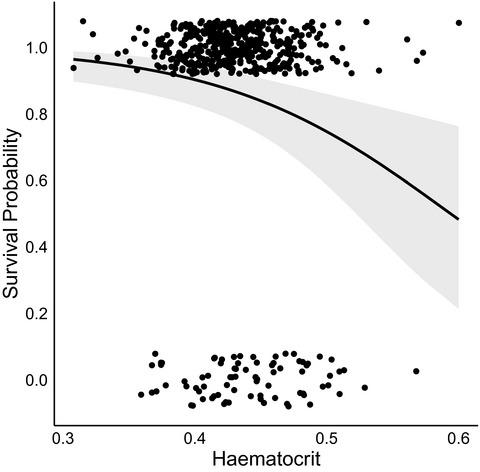当前位置:
X-MOL 学术
›
Ecol. Evol.
›
论文详情
Our official English website, www.x-mol.net, welcomes your
feedback! (Note: you will need to create a separate account there.)
Hematocrit, age, and survival in a wild vertebrate population
Ecology and Evolution ( IF 2.3 ) Pub Date : 2020-12-21 , DOI: 10.1002/ece3.7015 Thomas J Brown 1 , Martijn Hammers 2 , Martin Taylor 1 , Hannah L Dugdale 3 , Jan Komdeur 2 , David S Richardson 1, 4
Ecology and Evolution ( IF 2.3 ) Pub Date : 2020-12-21 , DOI: 10.1002/ece3.7015 Thomas J Brown 1 , Martijn Hammers 2 , Martin Taylor 1 , Hannah L Dugdale 3 , Jan Komdeur 2 , David S Richardson 1, 4
Affiliation

|
Understanding trade‐offs in wild populations is difficult, but important if we are to understand the evolution of life histories and the impact of ecological variables upon them. Markers that reflect physiological state and predict future survival would be of considerable benefit to unraveling such trade‐offs and could provide insight into individual variation in senescence. However, currently used markers often yield inconsistent results. One underutilized measure is hematocrit, the proportion of blood comprising erythrocytes, which relates to the blood's oxygen‐carrying capacity and viscosity, and to individual endurance. Hematocrit has been shown to decline with age in cross‐sectional studies (which may be confounded by selective appearance/disappearance). However, few studies have tested whether hematocrit declines within individuals or whether low hematocrit impacts survival in wild taxa. Using longitudinal data from the Seychelles warbler (Acrocephalus sechellensis), we demonstrated that hematocrit increases with age in young individuals (<1.5 years) but decreases with age in older individuals (1.5–13 years). In breeders, hematocrit was higher in males than females and varied relative to breeding stage. High hematocrit was associated with lower survival in young individuals, but not older individuals. Thus, while we did not find support for hematocrit as a marker of senescence, high hematocrit is indicative of poor condition in younger individuals. Possible explanations are that these individuals were experiencing dehydration and/or high endurance demands prior to capture, which warrants further investigation. Our study demonstrates that hematocrit can be an informative metric for life‐history studies investigating trade‐offs between survival, longevity, and reproduction.
中文翻译:

野生脊椎动物种群中的血细胞比容、年龄和存活率
了解野生种群的权衡是困难的,但如果我们要了解生命史的进化以及生态变量对其的影响,这一点很重要。反映生理状态并预测未来生存的标记对于解决这种权衡具有相当大的好处,并且可以提供对衰老个体差异的洞察。然而,目前使用的标记常常产生不一致的结果。一项未充分利用的指标是血细胞比容,即血液中红细胞的比例,它与血液的携氧能力和粘度以及个人耐力有关。横断面研究表明,血细胞比容随着年龄的增长而下降(这可能会因选择性出现/消失而混淆)。然而,很少有研究测试个体内的血细胞比容是否会下降,或者低血细胞比容是否会影响野生类群的生存。使用塞舌尔莺 ( Acrocephalus sechellensis ) 的纵向数据,我们证明,年轻个体(<1.5 岁)的血细胞比容随着年龄的增长而增加,但老年个体(1.5-13 岁)的血细胞比容随着年龄的增长而降低。在种鸡中,雄性的血细胞比容高于雌性,并且随繁殖阶段的不同而变化。高血细胞比容与年轻个体的较低存活率相关,但与老年个体无关。因此,虽然我们没有发现血细胞比容作为衰老标志的支持,但高血细胞比容表明年轻个体的状况不佳。可能的解释是,这些人在被捕前正在经历脱水和/或高耐力要求,这需要进一步调查。 我们的研究表明,血细胞比容可以作为生活史研究的一个信息指标,研究生存、寿命和繁殖之间的权衡。
更新日期:2021-01-08
中文翻译:

野生脊椎动物种群中的血细胞比容、年龄和存活率
了解野生种群的权衡是困难的,但如果我们要了解生命史的进化以及生态变量对其的影响,这一点很重要。反映生理状态并预测未来生存的标记对于解决这种权衡具有相当大的好处,并且可以提供对衰老个体差异的洞察。然而,目前使用的标记常常产生不一致的结果。一项未充分利用的指标是血细胞比容,即血液中红细胞的比例,它与血液的携氧能力和粘度以及个人耐力有关。横断面研究表明,血细胞比容随着年龄的增长而下降(这可能会因选择性出现/消失而混淆)。然而,很少有研究测试个体内的血细胞比容是否会下降,或者低血细胞比容是否会影响野生类群的生存。使用塞舌尔莺 ( Acrocephalus sechellensis ) 的纵向数据,我们证明,年轻个体(<1.5 岁)的血细胞比容随着年龄的增长而增加,但老年个体(1.5-13 岁)的血细胞比容随着年龄的增长而降低。在种鸡中,雄性的血细胞比容高于雌性,并且随繁殖阶段的不同而变化。高血细胞比容与年轻个体的较低存活率相关,但与老年个体无关。因此,虽然我们没有发现血细胞比容作为衰老标志的支持,但高血细胞比容表明年轻个体的状况不佳。可能的解释是,这些人在被捕前正在经历脱水和/或高耐力要求,这需要进一步调查。 我们的研究表明,血细胞比容可以作为生活史研究的一个信息指标,研究生存、寿命和繁殖之间的权衡。











































 京公网安备 11010802027423号
京公网安备 11010802027423号